
In taxonomy, binomial nomenclature, also called binominal nomenclature or binary nomenclature, is a formal system of naming species of living things by giving each a name composed of two parts, both of which use Latin grammatical forms, although they can be based on words from other languages. Such a name is called a binomial name, a binomen, binominal name or a scientific name; more informally it is also historically called a Latin name.
Bass is a name shared by many species of fish. The term encompasses both freshwater and marine species, all belonging to the large order Perciformes, or perch-like fishes. The word bass comes from Middle English bars, meaning 'perch'.
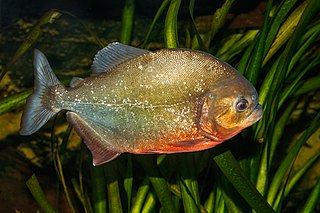
A piranha or piraña is one of a number of freshwater fish in the family Serrasalmidae, or the subfamily Serrasalminae within the tetra family, Characidae in order Characiformes. These fish inhabit South American rivers, floodplains, lakes and reservoirs. Although often described as extremely predatory and mainly feeding on fish, their dietary habits vary extensively, and they will also take plant material, leading to their classification as omnivorous.

Crappies are two species of North American freshwater fish of the genus Pomoxis in the family Centrarchidae (sunfishes). Both species of crappies are popular game fish among recreational anglers.

Halosaurs are eel-shaped fishes found only at great ocean depths. As the family Halosauridae, halosaurs are one of two families within the order Notacanthiformes; the other being the deep-sea spiny eels, Notacanthidae. Halosaurs are thought to have a worldwide distribution, with some 17 species in three genera represented. Only a handful of specimens have been observed alive, all in chance encounters with Remotely operated underwater vehicles.
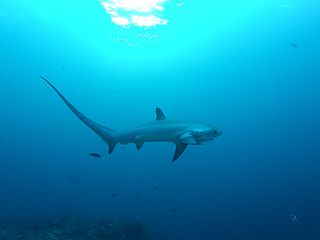
Thresher sharks are large lamniform sharks of the family Alopiidae found in all temperate and tropical oceans of the world; the family contains three extant species, all within the genus Alopias.
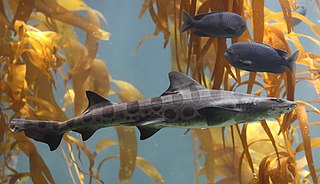
Triakis is a genus of houndsharks in the family Triakidae. The name comes from the Greek word τρι, tri meaning "three", and the Latin word acis meaning "sharp" or "pointed", in reference to the three-pointed teeth of these sharks.

The trumpetfishes are three species of highly specialized, tubularly-elongated marine fishes in the genus Aulostomus, of the monogeneric family Aulostomidae. The trumpetfishes are members of the order Syngnathiformes, together with the seahorses and the similarly built, closely related cornetfishes.
Sinocyclocheilus is a genus of freshwater fish in the family Cyprinidae endemic to China, where only found in Guangxi, Guizhou and Yunnan. Almost all of its species live in or around caves and most of these have adaptions typical of cavefish such as a lack of scales, lack of pigmentation and reduced eyes. Several species have an unusual hunchbacked appearance and some of the cave-dwellers have a "horn" on the back, the function of which is unclear. In contrast, the Sinocyclocheilus species that live aboveground, as well as a few found underground, show no clear cavefish adaptions. They are relatively small fish reaching up to 23 cm (9.1 in) in length. The individual species have small ranges and populations, leading to the status of most of the evaluated species as threatened. Many species populations in the genus have yet to be evaluated by the IUCN.
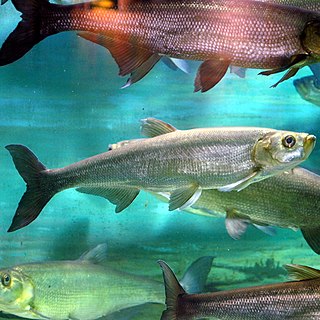
Chanodichthys is a genus of cyprinid freshwater fish, consisting of five species from eastern Asia. The name is derived from the Greek word chanos, meaning "abyss, mouth opened, inmensity", and the Greek word ichthys, meaning "fish". Chanodichthys is closely related to Culter and some species have been moved between these genera.
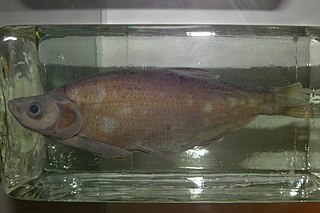
Culter is a genus of cyprinid fish, consisting of four species found in freshwater of eastern Asia. The name is derived from the Latin word culter, meaning "knife". Culter is closely related to Chanodichthys and some species have been moved between these genera.

Hemiculter is a genus of cyprinid fish, consisting of eight species native to fresh water of eastern Asia. The type species is the sharpbelly, Culter leucisculus. The name is derived from the Greek word hemis, meaning "half", and the Latin word culter, meaning "knife".

Megalobrama is a genus of cyprinid fish, consisting of six species native to fresh water in China and eastern Russia. The name is derived from the Greek word megalos, meaning "great", and the Old French word breme, a type of freshwater fish.

Barbodes is a genus of small to medium-sized cyprinid fish native to tropical Asia. The majority of the species are from Southeast Asia. Many species are threatened and some from the Philippines are already extinct. A survey carried out in 1992 only found three of the endemic Barbodes species, and only two were found in 2008. Several members of this genus were formerly included in Puntius.

Osteobrama is a genus of cyprinid fish found in southern Asia consisting of eight species. The name is derived from the Greek word osteon, meaning "bone", and the Old French word breme, a type of freshwater fish.

Microsynodontis is a genus of upside-down catfishes native to freshwater rivers in western Africa. The genus was originally described by British-Belgian zoologist George Albert Boulenger in 1903 based upon the type species Microsynodontis batesii. The name microsynodontis comes from the Greek word mikro, meaning small, and the Greek term synodon, meaning "with the teeth all growing together".

Synodontis macrostigma, known as the largespot squeaker, is a species of upside-down catfish that is native to Angola, Botswana, Namibia, South Africa and Zambia where it is found in the Cunene, Okavango, upper Zambezi and Kafue River systems. It was first described by British-Belgian zoologist George Albert Boulenger in 1911, from specimens collected in the Okovango River, Botswana, by R. B. Woosnam. The species name macrostigma is derived from the Greek word makros, meaning "large", and the Greek word stigma, meaning "mark" or "spot" and refers to the large spots on the sides of the fish.
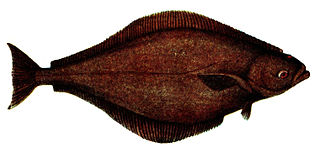
Hippoglossus is a genus of very large righteye flounders with one species native to the north Atlantic Ocean and one to the north Pacific Ocean.
Margariscus, known as the pearl daces, is a genus of leusiscid fishes found in North America. There are currently two recognized species in this genus. Margariscus comes from the Greek word margariskos, meaning pearl.
Australopachycormus is an extinct genus pachycormiform fish. It is only known from the type species, A. hurleyi, from the Early Cretaceous (Albian) Toolebuc Formation of Queensland, Australia. Like the related Protosphyraena, it possessed an elongated rostrum.
















